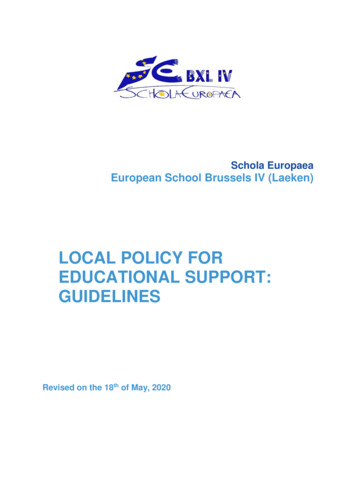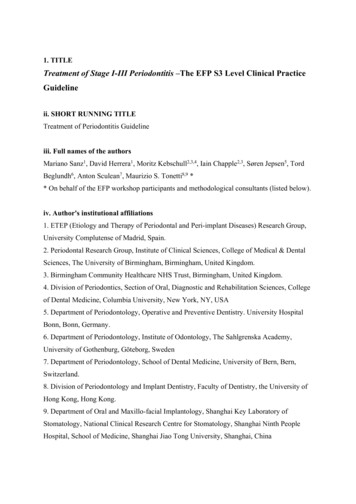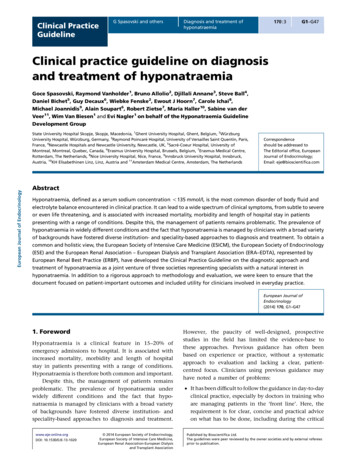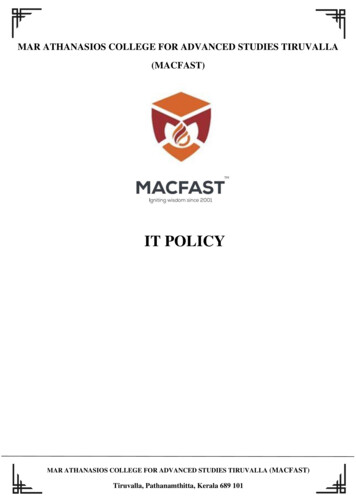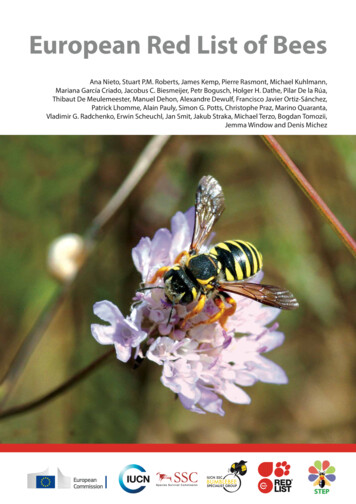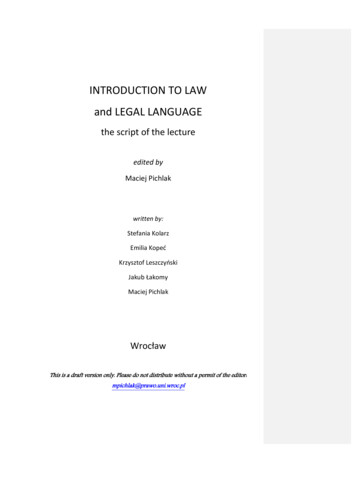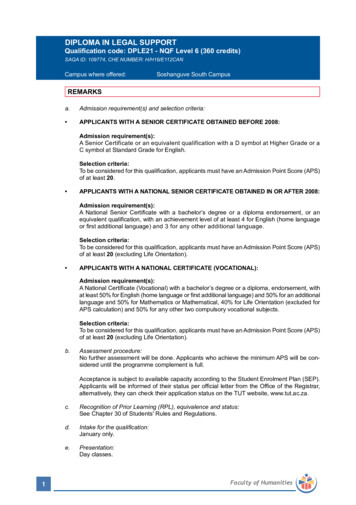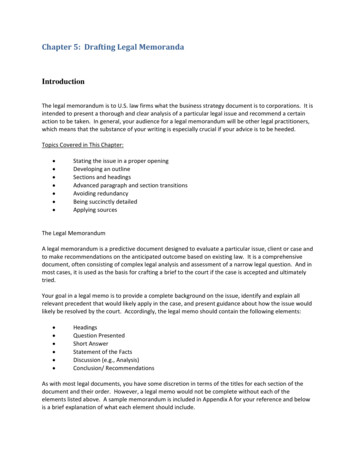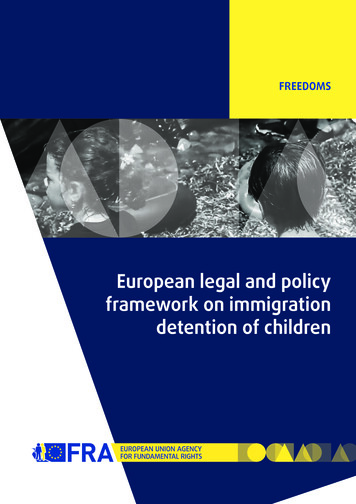
Transcription
FREEDOMSEuropean legal and policyframework on immigrationdetention of children
The report addresses matters related to the right to liberty and security (Article 6), to education (Article 14), to healthcare(Article 35), and the rights of the child (Article 24), falling under Title II 'Freedoms', Title III 'Equality', and Title IV 'Solidarity'of the Charter of Fundamental Rights of the European Union.Europe Direct is a service to help you find answersto your questions about the European Union.Freephone number (*):00 800 6 7 8 9 10 11(*) The information given is free, as are most calls (though some operators, phone boxes or hotels may charge you).Photo (cover & inside): European Union Agency for Fundamental RightsMore information on the European Union is available on the Internet (http://europa.eu).FRA – European Union Agency for Fundamental RightsSchwarzenbergplatz 11 – 1040 Vienna – AustriaTel. 43 158030-0 – Fax 43 158030-699Email: info@fra.europa.eu – fra.europa.euLuxembourg: Publications Office of the European Union, 2017PaperISBN -CPDFISBN -N European Union Agency for Fundamental Rights, 2017Reproduction is authorised, provided the source is acknowledged.Printed by Imprimerie Centrale in LuxembourgPrinted on process chlorine-free recycled paper (PCF)
European legal and policyframework on immigrationdetention of children
ForewordChildren have represented up to a third of migrant arrivals in the European Union (EU) since the summer of 2015.Upon arrival, they need and have a right to protection, in line with EU and international law. Detaining children formigration management or asylum reasons – with or without family members – is difficult to justify, practically verychallenging to implement in line with fundamental rights and clearly not in the child’s best interests.Current efforts to speed up asylum processing and make returns more effective may prompt an increased use ofimmigration detention, possibly also affecting children. This can entail serious risks of violating children’s right toliberty and security if the strict safeguards protecting children from arbitrary detention are disregarded. Childrenshould be placed in open centres that provide for the necessary protection and care to which they are entitled, andwhich promote their best interests.This report takes the rights of the child to protection and care set forth in Article 24 of the EU Charter of FundamentalRights as a starting point when examining the content of the right to liberty and security. It outlines the mainfundamental rights safeguards provided for in EU and human rights law to prevent unlawful and arbitrary detention.It also describes practical examples from the Member States, drawing on promising practices wherever possible. Inso doing, it aims to assist asylum and migration practitioners in implementing policies in line with the law, so thatimmigration detention of children ends or becomes truly exceptional.Michael O’FlahertyDirector3
Country codes4Country zech loveniaUKUnited Kingdom
ContentsFOREWORD 3EXECUTIVE SUMMARY AND FRA OPINIONS 7INTRODUCTION 111 CHILDREN’S RIGHT TO PROTECTION AND CARE 191.1.Establishing whether an individual is a child 201.2.The ‘best interests of the child’ principle 22Conclusion 242 THE RIGHT TO LIBERTY AND SECURITY 252.1.Provisions applicable to all 262.2.Specific provisions for children 28Conclusion 303 LEGAL BASIS IN NATIONAL LAW 333.1.National laws on immigration detention of children 343.2. National laws banning detention below a certain age 39Conclusion 404 EXHAUSTIVE LIST OF GROUNDS FOR DETENTION 414.1.List of grounds under EU law 424.2. List of grounds under the ECHR 424.3. Discrepancies between the EU and ECHR legal systems 434.4. Inappropriate use of detention to protect the child 45Conclusion 455 ASSESSING NECESSITY AND PROPORTIONALITY 475.1.Last resort and alternatives to detention 495.2. Family life 525.3.Shortest appropriate period of time 58Conclusion 626 CHILD-SPECIFIC PROCEDURAL SAFEGUARDS 636.1.Child-friendly information and procedures 646.2. Guardianship and legal representation 66Conclusion 687 HUMANE AND DIGNIFIED CONDITIONS IN DETENTION 697.1.Facilities 737.2.Child-specific training 787.3.Right to education 807.4. Healthcare 82Conclusion 858 OVERSIGHT MECHANISMS 878.1.Independent monitoring bodies 878.2. Child protection authorities 918.3. Schengen evaluations 928.4. Complaint mechanisms 93Conclusion 94REFERENCES 97ANNEX: LEGAL PROVISIONS 1055
Executive summary and FRA opinionsA significant number of children are detained in theEuropean Union (EU) during their asylum and returnprocedures or to secure their removal. Detention undeniably affects children, including their immediate andlong-term mental health, experts report – and it canaffect them long after their release.Immigration detention of children remains a majorfundamental rights challenge in the EU. A person’sright to liberty and security is a fundamental right, asenshrined in Article 6 of the EU Charter of FundamentalRights (the Charter), Article 5 of the European Convention on Human Rights (ECHR) and in several UN treatyinstruments. Any restriction of this right must respectthe requirements established by international, European and domestic law, which are particularly strict forchildren. Although EU law does not prohibit immigration detention of children, the stringent requirementsflowing from the Charter and the ECHR mean that deprivation of liberty will only be in line with EU law inexceptional cases.Children’s right to protection and care and the principleof the best interests of the child are the starting pointswhen examining deprivation of liberty of children.To be lawful, national law must provide for the possibilityof detention. It must also be closely connected to one ofthe exhaustive grounds listed in EU law and in Article 5of the ECHR. To avoid being deemed arbitrary, detentionmust be for the shortest period of time that is reasonably required to fulfil the purpose of detention, namely“to prevent [a person] effecting an unauthorised entryinto the country or of a person against whom action isbeing taken with a view to deportation or extradition”(Article 5 (1) (f)).EU and human rights law prohibit automatic detention.An individual examination is always needed beforeordering or extending detention. Such examinationmust assess if deprivation of liberty is necessary andproportionate in the individual case. When it concernschildren, a primary consideration must be given to thebest interests of the child, taking into account thatimmigration detention is not in the child’s best interests.Respecting the right to liberty and security requiresstates to adopt less intrusive alternatives to detention.Where the authorities fail to examine all alternatives –including placement in an open facility without restrictions to the child’s fundamental rights – the detentionof a child will be considered arbitrary and a violation oftheir right to liberty and security.Strict procedural safeguards – such as the right to judicialreview, access to free legal aid and linguistic assistance– protect all individuals from arbitrary deprivation ofliberty. For children, these general safeguards are complemented by the duty to conduct procedures and provide information in a child-friendly manner. Moreover,a legal guardian must be assigned to unaccompaniedchildren.When EU Member States exceptionally resort todeprivation of liberty, people must be held in a placeand under conditions that are appropriate. MostEU Member States that allow for the possibility ofdetaining children have established specialised facilities, either separately or as distinct parts of existingdetention facilities. Conditions in these facilities varysignificantly and change over time. One of the characteristics of detention facilities adapted to host childrenis the presence of child-friendly spaces. However, manyfacilities are like prisons: officers wear fatigues; there isbarbed wire; and handcuffs are used for transport. Veryfew of the specialised facilities employ staff who havereceived specific training on child protection.Short-term holding facilities are often not equipped forholding children and are usually not subject to the samelevel of independent monitoring as immigration detention facilities. The quality of services and treatment isparticularly difficult to uphold when arrivals increaseand authorities have to use facilities not intended fordetention.National Human Rights Institutions, particularly NationalPreventive Mechanisms set up by EU Member Statesunder the Optional Protocol to the UN ConventionAgainst Torture, are important in preventing unlawful orarbitrary detention. They complement the work done byinternational monitoring bodies, principally the Councilof Europe’s Committee for the Prevention of Torture andInhuman or Degrading Treatment or Punishment (CPT).National child protection authorities could play animportant role in safeguarding children’s right to liberty and in promoting the well-being of detained children. They could help assess the child’s best interestswhen authorities consider detaining children togetherwith their parents, oversee child detention standardsand run complaint mechanisms smoothly. However, inmany Member States, child protection authorities donot actively take part in deciding whether or not a childshould be detained, or in monitoring detention facilities.7
European legal and policy framework on immigration detention of childrenFRA opinionsEnsuring children’s right to protectionand careFRA opinion 2The right of children to protection and care and theprinciple of the best interests of the child as set outin Article 24 of the EU Charter of Fundamental Rightsare the starting points when examining deprivation ofliberty of children. As noted by the European Commission in its 2017 Communication on the protection ofchildren in migration, in some instances, children havebeen accommodated in closed facilities due to a shortage of suitable alternative reception facilities.To protect the right to liberty and security(Article 6 of the Charter), EU Member Statesare encouraged to introduce more favourableprovisions in national laws – as envisaged inArticle 4 (3) of the Return Directive and Article 4of the Reception Conditions Directive – eitherprohibiting or further restricting the possibilityto detain children for immigration purposes. Thiswould significantly contribute to avoiding the riskof arbitrary detention of children.Prompt identification of children is needed to triggerthe special protection to which children are entitled.Concerning asylum detention, the current reformof the asylum acquis is an opportunity forEU legislators to take a stronger stand againstchild detention.FRA opinion 1To promote children’s right to protection andcare, the EU and its Member States shoulddevelop credible and effective systems thatwould make it unnecessary to detain children forasylum or return purposes, regardless of whetherthey are in the EU alone or with their families.This could include building on, for example, casemanagement, alternative housing, counsellingand coaching.EU Member States should use age assessmentsonly where there are grounds for serious doubtabout an individual’s age. Age assessmentprocedures should take into account children’srights. Independent experts, familiar with therespective child’s cultural background and fullyrespecting the child’s dignity, should undertake ina gender-appropriate manner age assessments.Recognising that age assessments cannot beprecise, in cases of doubt, authorities should treatthe person as a child. They should also permitappeals against age assessment decisions. Theforthcoming European Asylum Support Office(EASO) guidance should provide further adviceto EU Member States on how to apply theseconsiderations in practice.Fully respecting children’s rightto liberty and securityA person’s right to liberty and security, as enshrined inEU, Council of Europe and UN instruments, is a fundamental right. Any restriction of this right must respectthe requirements established by international, Europeanand national law, which are particularly strict for children. Neither EU law nor the ECHR prohibit immigrationdetention of children. The stringent requirements flowing from the Charter and the case law of the EuropeanCourt of Human Rights (ECtHR) mean, however, that only8in exceptional cases depriving children of liberty will bein line with EU law.EU Member States should systematically collectdisaggregate data on children in immigrationdetention, while the European Commissionshould encourage the comparability of such datathrough Eurostat.Establishing clear legal basis fordetention in national lawFor detention to be lawful, it is essential under EU law,the ECHR and international law that national law provides for the possibility to detain non-nationals forimmigration or asylum purposes. In the absence ofa clear domestic legal basis, no detention whatsoevercan be deemed lawful. Several EU Member Statesmanage their asylum and return policies without resorting to deprivation of liberty.FRA opinion 3The European Commission should disseminateinformation about and promote EU MemberStates’ positive experiences with managingtheir asylum and return policies withoutresorting to child detention or resorting to it invery exceptional cases only. The forthcoming2017 European Forum on the Rights of the Childcould be an ideal venue for taking the first stepregarding this.Adhering strictly to the exhaustive listof detention groundsThe ECHR and EU law list exhaustive but not identicalpermissible grounds for detention, which apply to everyone regardless of age. EU Member States must strictlyadhere to these detention grounds, which have to be
Executive summary and FRA opinionsinterpreted restrictively, according to Article 18 of theECHR. In practice, immigration detention is sometimesimposed for public order-based reasons.FRA opinion 4Domestic legislation regulating immigration orasylum should not be used to detain individualson grounds of public order, thereby circumventingthe safeguards established under human rightslaw for criminal detention. EU Member Statesshould ensure that grounds for immigrationdetention established at national level do notextend beyond the exhaustive list of legitimategrounds listed in Article 5 (1) of the ECHR, as wellas those permissible under the EU asylum andreturn acquis.Detention to secure return is not lawful in theabsence of realistic prospects for removal.EU Member States could consider introducinga presumption against pre-removal detentionfor de jure as well as de facto stateless persons,including children. This should be one in caseswhere it is evident from past experience thatthe country of former habitual residence willnot readmit the person or, for de facto statelesspersons, the country of nationality will refuseany cooperation in establishing the citizenshipand issuing related travel documents.Given its short- and long-term consequenceson children’s development, EU Member Statesshould not use deprivation of liberty as a means toprotect children from exploitation and to mitigaterisks of them going missing. These risks shouldbe countered by improving reception conditions(including by assigning specialised support staffon a 24/7 basis); strengthening guardianshipsystems; and gaining a better understanding ofwhy children go missing and what can be doneto prevent their disappearance. These effortsshould be accompanied by effective mechanismsto record when a child goes missing and to followup when the child is found again, as FRA pointsout in its Opinion on the impact on fundamentalrights of the proposal for a revised EurodacRegulation.Assessing necessity and proportionalityEU and human rights law prohibit automatic detention;an individual examination is therefore always neededbefore ordering detention. In practice, detention decisions involving children are not necessarily basedon careful, individual assessments of necessity andproportionality, as required by Articles 6 and 52 (1)of the Charter. In addition, they do not always giveprimary consideration to the best interests of the child.Regarding the length of detention, for all persons andnot just children, European and international law requireimmigration detention to be only as long as necessaryand to last for the shortest appropriate period.FRA opinion 5Where they have not yet done so, EU MemberStates should issue simple and practicableinstructions to support officers responsible forpreparing or issuing detention decisions. Theseinstructions should advise officers on the steps totake to ensure that necessity and proportionalityare adequately assessed in each individual case,giving primary consideration to the best interestsof the child.EU Member States must take adequate legislativeand policy measures to ensure that alternativesto detention are not only available on paper butalso used in practice for families and children.In the absence of such measures, nationalauthorities cannot justify the use of detention asa last resort.When deciding whether or not to detain a familywith children, EU Member States should alwaysthoroughly assess the best interests of the child,which means being with the parents in openfacilities that enable the family to live withdignity. If they are detained, detention has totake place in facilities adequately equipped tohost families, also duly taking into account thelength of the deprivation of liberty.EU Member States that allow immigrationdetention of children should consider fixinga maximum length of child detention. This shouldbe coupled with regular judicial reviews of thenecessity and proportionality of detention, whichshould be based on an individual assessment ofthe child’s situation by the competent nationalchild protection authorities.Applying child-specific proceduralsafeguardsTo ensure that detention is neither unlawful nor arbitraryand, when imposed, does not limit fundamental rightsunduly, European and international law provides a set ofprocedural safeguards. These include the right to judicialreview, access to free legal aid and linguistic assistance.Alongside these general safeguards, child-specific safeguards exist, such as appointing guardians for unaccompanied children, as well as conducting proceduresand providing information in a child-friendly manner.9
European legal and policy framework on immigration detention of childrenFRA opinion 6To ensure children’s right to be heard, whichis a general principle of EU law, EU MemberStates should develop and use child-friendlyinformation and materials, and train officersand other relevant staff to conduct proceduresin a child-appropriate manner and facilitatechildren’s involvement.In light of Article 24 of the Charter (rights ofthe child), EU Member States should appointa guardian as soon as an unaccompanied child isidentified and before they decide on deprivationof liberty.Ensuring humane and dignifieddetention conditionsEvery detention facility at which children are held asasylum seekers or for the purpose of removal mustensure humane and dignified detention conditions.Strict legal standards have been developed at EU, Council of Europe and international levels. Even if detentionin the migration context is based on valid grounds prescribed by law and fulfils the formal criteria of legality,the conditions of detention may result in breaches ofEU law and render deprivation of liberty arbitrary.FRA opinion 7Asylum-seeking children and children in returnprocedures must not be deprived of liberty ifavailable facilities do not guarantee minimumstandards for the child’s well-being. To achievethis, EU Member States must create child-friendlyspaces and take effective measures to preventholding facilities from being like prisons. Thisaffects infrastructure (such as removing barbedwire or bars on windows), the use of force (e.g.avoiding systematic handcuffing of childrenor their parents during transport), reducingthe number of uniformed and armed staff, andadopting flexible house rules (e.g. free access tothe yard).To guarantee the right to education set out inArticle 14 of the Charter, EU Member States mustprovide children with access to education. Wheredetention lasts longer than a very short period,education must be provided. Children shouldhave access to a formal education system, taughtby qualified teachers through programmesintegrated in the country’s education system.Priority should be given to providing educationoutside of detention facilities.10EU Member States should take proactivemeasures to guarantee detained children theright to healthcare enshrined in Article 35 of theCharter. To that end, they should ensure regularvisits by paediatricians from outside the facilities,provide effective interpretation services andensure accessibility of medicines. Medicalconsultations and medical information must beconfidential and child-appropriate.Using effective oversight mechanismsPersons deprived of liberty are confined to locationsthat are not subject to public scrutiny, so are at a higherrisk of facing human rights violations. Therefore, effective oversight mechanisms are necessary to preventabuse and essential to ensure accountability for potential human rights violations. These oversight systemsinclude international, EU (Schengen evaluations underRegulation (EU) No. 1053/2013) and national mechanisms, such as independent monitoring bodies or childprotection authorities. In addition, effective complaintsprocedures represent a basic safeguard against ill-treatment in detention.FRA opinion 8When designing approaches to immigrationdetention of children, EU Member State authoritiesshould make full use of the advice and engagethe participation of ombuds institutions andNational Human Rights Institutions, especiallythose with child-specific mandates.Child protection authorities in EU Member Statesshould devote primary attention to childrendeprived of liberty for immigration purposes.Responsible authorities should consult childprotection agencies, at least when assessingwhether or not to detain a child together withtheir parents. Child protection authorities shouldalso regularly visit children held in immigrationdetention.The European Commission could considerundertaking unannounced Schengen evaluationvisits if there is evidence of arbitrary use of childdetention pending removal in a given EU MemberState.EU Member States should ensure that eachdetention or other holding facility offers childaccessible ways to submit complaints, forexample through a complaint box, and that theyinform children in a child-friendly manner abouttheir right to lodge a complaint. Responsibleauthorities should follow up on each individualcomplaint.
IntroductionSince 2016, various EU Member States have beenattempting to speed up asylum processing and to makereturns more effective. Such efforts are likely to promptan increase in the use of detention, including to prevent absconding – possibly also affecting children. Thisreport takes a closer look at detention of third-countrynational children for migration management or asylumpurposes – referred to as ‘immigration detention’.The report covers unaccompanied children – childrenwho are not accompanied by their parents or a primarycaregiver – and children who are detained together withtheir parents. A child is any person under the age of18 years. The report does not address detention forcriminal offences.Detention and deprivation of liberty are used assynonyms throughout the report. They describe anyform of co
The report addresses matters related to the right to liberty and security (Article 6), to education (Article 14), to healthcare (Article 35), and the rights of the child (Article 24), falling under Title II 'Freedoms', Title III 'Equality', and Title IV 'Solidarity'
